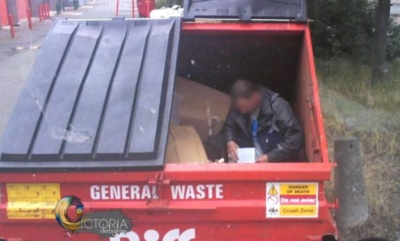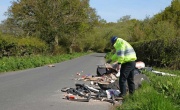Rough sleepers warned not to turn to bins as winter approaches
The dangers of sleeping in waste containers are being highlighted by a campaign as the incoming winter temperatures force more rough sleepers to seek covered shelter.
B&M Waste Services, a waste management firm based in the North West, is working in partnership with Shelter, a housing and homelessness charity, to launch its ‘Refuse not Refuge’ campaign, which raises awareness about the dangers of taking shelter in waste containers.

However, those that do sleep in bins are putting their lives at risk, as people are often still inside when the bin is emptied and are tipped into collection vehicles, which often compress and shred material to increase capacity.
B&M says that with the Christmas party season approaching, there is an added risk of people opting to stay in bins rather than getting home, with a recent survey conducted in partnership with Streetlink finding that 11 per cent of those sleeping in bins were people returning from a night out.
Earlier this year, a man had a lucky escape in Cumbria when he was noticed in a collection vehicle having been tipped in after sleeping rough following a night out in Workington.
There have been a number of tragedies in the industry, where people have been injured and even killed after sleeping in a bin. According to the Environmental Services Association (ESA), there have been a total of 11 deaths since October 2010 due to people sleeping in bins.
In August 2015, a 34 year-old man, Mathew Symonds, who had been sleeping rough after being turned away by his hostel, was found crushed to death at Biffa’s Avonmouth depot, an hour after an industrial waste bin had been emptied onto a conveyor.

B&M are seeking to partner with customers to assist them in raising awareness by displaying posters around their site and mentioning the campaign on social media.
David Curtis, Director at B&M Waste Services, said: “A recent study conducted in partnership with Streetlink indicated that it’s not only homeless people but also drunken students and party goers who sleep in bins, a massive 11 per cent.
"This is why we are working with our customers, particularly universities, colleges and retail parks to apply best practice in reducing this risk through raising awareness of the problem.’’
Checking bins is not a load of rubbish
The number of homeless people found sleeping rough in recycling bins is growing according to waste management company Biffa, which has also previously run an awareness campaign with the charity Streetlink. Biffa found that in 2014/15, there had been 93 people found in the company’s bins, whilst this figure had risen to 175 in 2015/2016.
Official figures released by the Department for Communities and Local Government in February suggest that in England there has been an increase of 30 per cent in a year of people sleeping rough.
A survey by Biffa found in 2014 that around two-thirds of organisations did not have in place a policy to check for people sleeping in bins, and, worryingly, 40 per cent of the time, anyone sheltering in a bin was not discovered until the loading operation had begun.
In an attempt to counter the problem, Biffa trucks now contain cameras in the vehicle’s compactor that allow drivers to see what is being tipped inside (see the video above). However, some collection trucks lift containers up to six metres high before the contents are tipped into the vehicles’ compactors, so even if someone is spotted on the internal camera of the truck before compaction, there is a high risk of injury from falling.
More information about B&M Waste’s ‘Refuse not Refuge’ campaign can be found on the company’s website.








